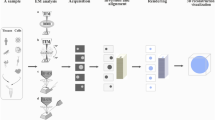Abstract
Focused ion beam/scanning electron microscopy (FIB/SEM) tomography is a novel powerful approach for three-dimensional (3D) imaging of biological samples. Thereby, a sample is repeatedly milled with the focused ion beam (FIB) and each newly produced block face is imaged with the scanning electron microscope (SEM). This process can be repeated ad libitum in arbitrarily small increments allowing 3D analysis of relatively large volumes such as eukaryotic cells. High-pressure freezing and freeze substitution, on the other hand, are the gold standards for electron microscopic preparation of whole cells. In this work, we combined these methods and substantially improved resolution by using the secondary electron signal for image formation. With this imaging mode, contrast is formed in a very small, well-defined area close to the newly produced surface. By using this approach, small features, so far only visible in transmission electron microscope (TEM) (e.g., the two leaflets of the membrane bi-layer, clathrin coats and cytoskeletal elements), can be resolved directly in the FIB/SEM in the 3D context of whole cells.





Similar content being viewed by others
References
Aoyama K, Takagi T, Hirase A, Miyazawa A (2008) STEM tomography for thick biological specimens. Ultramicroscopy 109:70–80
Baumeister W (2004) Mapping molecular landscapes inside cells. Biol Chem 385:865–872
Bernstein GH, Carter AD, Joy DC (2012) Do SE(II) electrons really degrade SEM image quality? Scanning. doi:10.1002/sca.21027 [Epub ahead of print]
Burkhardt C, Gnauck P, Wolburg H, Nisch W (2005) Serial block-face sectioning and high resolution imaging of biological samples with a crossbeam FIB/FESEM microscope. In: Proceedings of the microscopy conference 2005, Davos, p 106
Buser C, Walther P (2008) Freeze-substitution: the addition of water to polar solvents enhances the retention of structure and acts at temperatures around −60 °C. J Mircrosc 230:268–277
Hekking LH, Lebbink MN, De Winter DA, Schneijdenberg CT, Brand CM, Humbel BM, Verkleij AJ, Post JA (2009) Focused ion beam-scanning electron microscope: exploring large volumes of atherosclerotic tissue. J Microsc 235:336–347
Heymann JA, Hayles M, Gestmann I, Giannuzzi LA, Lich B, Subramaniam S (2006) Site-specific 3D imaging of cells and tissues with a dual beam microscope. J Struct Biol 155:63–73
Hohmann-Marriott MF, Sousa AA, Azari AA, Glushakova S, Zhang G, Zimmerberg J, Leapman RD (2009) Nanoscale 3D cellular imaging by axial scanning transmission electron tomography. Nat Methods 6:729–731
Höhn K, Sailer M, Wang L, Lorenz L, Schneider EM, Walther P (2011) Preparation of cryofixed cells for improved 3D ultrastructure with scanning transmission electron tomography. Histochem Cell Biol 135:1–9
Höög JL, Schwartz C, Noon AT, O’Toole ET, Mastronarde DN, McIntosh JR, Antony C (2007) Organization of interphase microtubules in fission yeast analyzed by electron tomography. Dev Cell 12:349–361
Hoppe W, Gassmann J, Hunsmann N, Schramm HJ, Sturm M (1974) Three-dimensional reconstruction of individual negatively stained yeast fatty-acid synthetase molecules from tilt series in the electron microscope. Z Physiol Chem 355:1483–1487
Joy D (2009) Second best no more. Nat Mater 8:776–777
Knott G, Rosset S, Cantoni M (2011) Focussed ion beam milling and scanning electron microscopy of brain tissue. J Vis Exp 6(53):e2588
Kremer JR, Mastronarde DN, McIntosh JR (1996) Computer visualization of three-dimensional image data using IMOD. J Struct Biol 116:71–76
McDonald K (2007) Cryopreparation methods for electron microscopy of selected model systems. In: McIntosh JR (ed) Cellular electron microscopy (methods in cell biology), vol 79. Elsevier, Amsterdam, pp 23–56
Pawley J (2008) LVSEM for biology. In: Schatten H, Pawley JB (eds) Biological low-voltage scanning electron microscopy. Springer, New York, pp 27–106
Peters K-R (1986) Rationale for the application of thin, continuous metal films in high magnification electron microscopy. J Microsc 142:25–34
Schneider P, Meier M, Wepf R, Müller R (2011) Serial FIB/SEM imaging for quantitative 3D assessment of the osteocyte lacuno-canalicular network. Bone 49:304–311
Seiler H (1967) Einige aktuelle Probleme der Sekundärelektronenemission. Z Angew Phy 22:249–263
Walther P, Ziegler A (2002) Freeze substitution of high-pressure frozen samples: the visibility of biological membranes is improved when the substitution medium contains water. J Microsc 208:3–10
Zhu Y, Inada H, Nakamura K, Wall J (2009) Imaging single atoms using secondary electrons with an aberration-corrected electron microscope. Nat Mater 8:808–812
Acknowledgments
We thank Renate Kunz, Eberhard Schmid and Reinhard Weih for excellent technical assistance. This project was partially supported by the BMBF project NanoCombine. BM and CK acknowledge the support by FEI Co. (Eindhoven, Netherlands), the German Science Foundation (INST40/385-F1UG) and the Struktur- und Innovationsfonds Baden-Wuerttemberg.
Author information
Authors and Affiliations
Corresponding author
Electronic supplementary material
Below is the link to the electronic supplementary material.
418_2012_1020_MOESM1_ESM.m4v
Video 1: FIB/SEM dataset of Fig. 2 according to Protocol A. A Volume of 25 μm × 19 μm × 6.5 μm is visible in this slice and view dataset. The ultrastructural features such as mitochondria or the Golgi apparatus are well preserved and well resolved (M4V 27,070 kb)
418_2012_1020_MOESM2_ESM.m4v
Video 2: FIB/SEM dataset of Fig. 4 according to Protocol B. A volume of about 2 μm × 1.5 μm × 3 μm is visible in this “slice and view” dataset, recorded at high magnification. Note the good visibility of fine structural details such as the two leaflets of the membrane bi-layer and ribosomes (M4V 9,710 kb)
Rights and permissions
About this article
Cite this article
Villinger, C., Gregorius, H., Kranz, C. et al. FIB/SEM tomography with TEM-like resolution for 3D imaging of high-pressure frozen cells. Histochem Cell Biol 138, 549–556 (2012). https://doi.org/10.1007/s00418-012-1020-6
Accepted:
Published:
Issue Date:
DOI: https://doi.org/10.1007/s00418-012-1020-6




